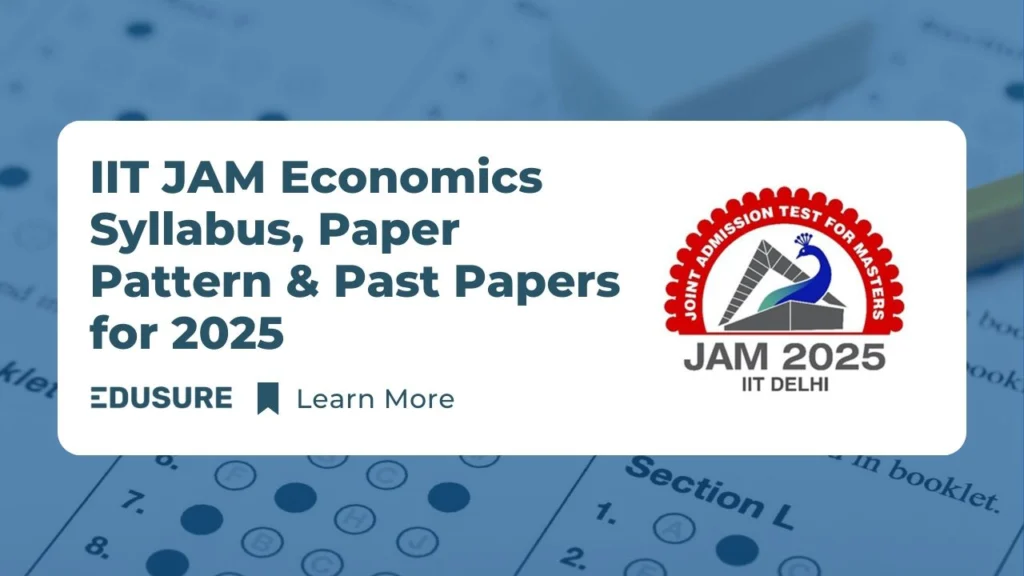

Here are your detailed information on IIT JAM 2025 Economics Syllabus, Paper Pattern & Past Papers. Are you gearing up to take the IIT JAM 2025 exam for a Master’s in Economics? This blog provides all the essential information you need, including details about the exam paper, syllabus, and past year question papers.
Microeconomics
Preference, utility and representation theorem, budget constraint, choice, demand (ordinary and compensated), Slutsky equation, revealed preference axioms
Production technology, isoquants, production function with one and more inputs, returns to scale, short run and long run costs, cost curves in the short run and long run
Equilibrium and efficiency under pure exchange and production, welfare economics, theorems of welfare economics
Perfect competition, monopoly, pricing with market power, price discrimination (first, second and third), monopolistic competition and oligopoly
Strategic form games, iterated elimination of dominated strategies, Nash equilibrium, mixed extension and mixed strategy Nash equilibrium, examples: Cournot, Bertrand duopolies, Prisoner’s dilemma
Externalities, public goods and markets with asymmetric information (adverse selection and moral hazard)
Macroeconomics
Structure, key concepts, measurements, and circular flow of income – for closed and open economy, money, fiscal and foreign sector variables – concepts and measurements
Consumption functions – absolute income hypothesis, life-cycle and permanent income hypothesis, random walk model of consumption, investment functions – Keynesian, money demand and supply functions, production function
Business cycles-facts and features, the Classical model of the business cycle, the Keynesian model of the business cycle, simple Keynesian cross model of income and employment determination and the multiplier (in a closed economy), IS-LM Model, Hicks’ IS-LM synthesis, role of monetary and fiscal policies
Open economy, Mundell- Fleming model, Keynesian flexible price (aggregate demand and aggregate supply) model, role of monetary and fiscal policies
Inflation – theories, measurement, causes, and effects, unemployment – types, measurement, causes, and effects
Harrod-Domar, Solow and Neo-classical growth models (AK model, Romer model and Schumpeterian growth model)
Statistics for Economics
Sample space and events, axioms of probability and their properties, conditional probability and Bayes’ rule, independent events, random variables and probability distributions, expectation, variance and higher order moments, functions of random variables, properties of commonly used discrete and continuous distributions, density and distribution functions for jointly distributed random variables, mean and variance of jointly distributed random variables, covariance and correlation coefficients
Random sampling, types of sampling, point and interval estimation, estimation of population parameters using methods of moments and maximum likelihood procedures, properties of estimators, sampling distribution, confidence intervals, central limit theorem, law of large numbers
distributions of test statistics, testing hypotheses related to population parameters, Type I and Type II errors, the power of a test, tests for comparing parameters from two samples
Correlation and types of correlation, the nature of regression analysis, method of Ordinary Least Squares (OLS), CLRM assumptions, properties of OLS, goodness of fit, variance and covariance of OLS estimator
Indian Economy
Transfer of tribute, deindustrialization of India
India’s achievements in health, education and other social sectors, disparities between Indian States in human development
Methodology of poverty estimation, Issues in poverty estimation in India
unemployment, labour force participation rates
Planning models, relation between agricultural and industrial growth, challenges faced by Indian planning
Balance of payments crisis in 1991, major aspects of economic reforms in India after 1991, reforms in trade and foreign investment
aspects of banking in India, CRR and SLR, financial sector reforms in India, fiscal and monetary policy, savings and investment rates in India
Mathematics for Economics
Set theory and number theory, elementary functions: quadratic, polynomial, power, exponential, logarithmic, functions of several variables, graphs and level curves, convex set, concavity and quasiconcavity of function, convexity and quasi-convexity of functions, sequences and series: convergence, algebraic properties and applications, complex numbers and its geometrical representation, De Moivre’s theorem and its application
Limits, continuity and differentiability, mean value theorems, Taylor’s theorem, partial differentiation, gradient, chain rule, second and higher order derivatives: properties and applications, implicit function theorem, and application to comparative statics problems, homogeneous and homothetic functions: characterisations and applications
Definite integrals, fundamental theorems, indefinite integrals and applications
First order difference equations, first order differential equations and applications
Matrix representations and elementary operations, systems of linear equations: properties of their solution, linear independence and dependence, rank, determinants, eigenvectors and eigenvalues of square matrices, symmetric matrices and quadratic forms, definiteness and semidefiniteness of quadratic forms
Local and global optima: geometric and calculus-based characterisations, and applications, multivariate optimization, constrained optimization and method of Lagrange multiplier, second order condition of optima, definiteness and optimality, properties of value function: envelope theorem and applications, linear programming: graphical solution, matrix formulation, duality, economic interpretation.
After knowing about the IIT JAM 2025 Economics syllabus, the paper pattern should be known to a candidate. The paper is a computer based test.
Duration of the Exam | 3 hours |
Number of Questions | 60 |
Total Marks | 100 |
Section Wise Split | Section A (Multiple Choice Questions): 10 Questions (1 Mark each) 20 Questions (2 Marks each) Section B (Multiple Select Questions): 10 Questions (2 Marks each) [One or more answers correct] Section C (Numerical Answer Type Questions): 10 Questions (1 Mark each) 10 Questions (2 Marks each) |
Negative Marking | Section A: -⅓ for each 1 Mark question answered incorrectly -⅔ for each 2 Marks question answered incorrectly Section B & C: No negative marking |
Click here to know more about IIT JAM 2025 Economics Syllabus, get your past papers and sample video solutions.
Looking for IIT JAM coaching online for Masters in Economics Entrances? You are in the RIGHT place! Click here and reach out to us now.
You can get all the past papers as per the IIT JAM 2025 Economics syllabus by clicking here.
With this we come to the end of the blog, now you have all the essential details as per the IIT JAM 2025 Economics syllabus and the past year papers.
Don’t miss out on becoming the RANK 1! Get the right IIT JAM Coaching and IIT GATE Coaching for your preparation. Click here and take your first step.
You may also be interested in the other blogs about IIT JAM on our website – where we have covered other details like the institutes you can get into, important dates, application.
Suggested for you
IIT JAM 2025 is scheduled to be held on Sunday, February 2, 2025. Prepare ahead and stay updated with important exam dates!
The total duration of the IIT JAM 2025 examination is 3 hours (180 minutes)
JAM score is valid for only ONE year.
IIT JAM 2025 has approximately 90+ seats available for postgraduate programs for Economics.
The Indian Institute of Technology (IIT) Delhi is the organizing institute for the Joint Admission Test for Masters (JAM) 2025.
EduSure has one of the best and the most structured programmes to crack the Masters in Economics Entrance Exams. It’s a 12-year-old Institute with students having Rank 1 in DSE, JNU, IGIDR, and IIT amongst other exams consistently in the last few years.
To see student testimonials of EduSure and hear about their success : www.youtube.com/edusureschool
To speak to an EduSure student counsellor, please fill out this Enquiry Form or call on 8100824600/01
For course enrolment, drop in your details on https://edusure.in/contact/ and we shall get back to you!
Ask a Question: [email protected]
Subscribe: https://www.youtube.com/c/EduSureSchool
Instagram: https://www.instagram.com/edusureschool/
Quora: https://www.quora.com/profile/EduSure-School
Facebook: https://www.facebook.com/Edusure?mibextid=ZbWKwL
We hope this was helpful.
Happy Learning!!

Full information PDF on MA Economics Entrance preparation in India
Get personalized advice on the best coaching for an MA in Economics. Click below to schedule a FREE counseling session with our expert advisors and explore available slots today!
Follow Us Now on

EduSure School is a 14+ year institute, with ISI/DSE faculty, Solely focused on MA Economics Entrance Exams.
WhatsApp us